[Estimated time: 10 mins]
I was chatting the other day with a friend about AI and economic growth. In the middle of our conversation, she asked: “Why don’t productivity improvements reduce GDP?”
At first blush, this might sound like a silly question. It’s well-established that countries with higher levels of labour productivity—like the US, Norway and Switzerland—also have higher GDP on a per capita basis than countries with low levels of productivity. And the correlation is pretty damn strong. Clearly, then, productivity improvements increase GDP per capita, not reduce it.
Yet my friend’s question is a surprisingly deep one. The idea that productivity improvements should reduce GDP actually makes a lot of sense.1I’m mostly going to focus on GDP, but the same should also apply to GDP per capita if population stays constant. It is possible that productivity improvements may affect population sizes—such as by changing fertility rates—but I’m not going to get into that. And digging into the causal mechanisms behind this relationship between productivity and GDP can be rather illuminating.
Why productivity improvements should reduce GDP
If you find some way to produce the same level and quality of output with fewer inputs, you’ll get a productivity improvement.2You can also get a productivity improvement if you produce higher quality outputs with the same amount of inputs. Since quality is much harder to measure, I’ll be assuming constant quality throughout this post. Usually, when people talk about “productivity” without specifying what type, they’re referring to labour productivity—i.e. how much output you get for each hour you work. I’m going to focus on labour productivity in this post, but the same principle should apply to other factors such as capital or energy productivity as well—it just means you’ll get the same output for less capital, energy, etc.
So let’s say you’re a carpenter who makes a living carving chairs. It normally takes you 10 hours to carve one chair, so you can produce 4 chairs in a 40-hour week. But you’re just a small fry in your country’s overall chair industry, which sells a million chairs each year for $100 each, contributing $100 million to your country’s GDP.
Now, assume there’s a technological breakthrough. A researcher has discovered a superior chair-carving technique that doubles your productivity. Instead of taking 10 hours to carve a chair, you can do so in just 5 hours. Over the course of a 40-hour week, you can now produce 8 chairs.
But all of your competitors also have access to this marvellous new technique and can also double their chair production. So what happens?
One possibility is that all carpenters coordinate to halve their working hours. This keeps both the number of chairs and prices unchanged. In this case, the chair industry’s contribution to GDP stays the same as before. But behind that statistic, carpenters’ lives have improved as they can now work just 20 hours a week.
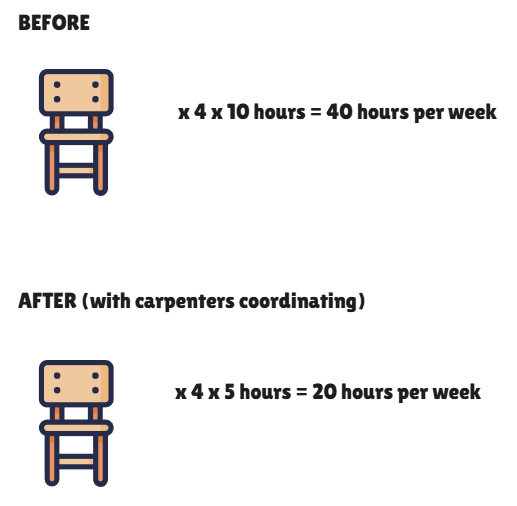
Of course, coordination (or “collusion”, from the point of view of a consumer) is pretty hard to maintain, especially when lots of carpenters are involved. It’s also usually illegal.
The more likely possibility if there are many carpenters is that chair prices will fall. If you’re still willing to work 40 hours per week, you could produce 8 chairs instead of 4. So you might try to lower your chair prices to $90 to undercut your competitors and earn $720 ($90 * 8) instead of just $400. The problem is that your competitors, thinking along the same lines, will then be tempted to lower their price to $80 to undercut you. Fierce competition among carpenters will drive down prices until they reach a competitive equilibrium price of $50. This 50% price drop matches the doubling in productivity that came from discovering the new chair-carving technique.
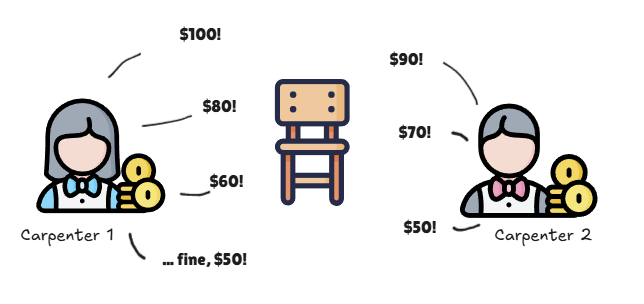
This might sound like bad news for carpenters, who end up working the same number of hours for the same amount of pay. Their entire productivity gain has been competed away. But it’s great news for anyone wanting to buy a chair.
What happens to GDP? Well, if the number of chairs sold each year stays the same at 1 million but the price of a chair has dropped to $50, then the chair industry only contributes $50 million to GDP, not $100 million. This means the superior chair-carving technique, which doubled productivity, will halve GDP.
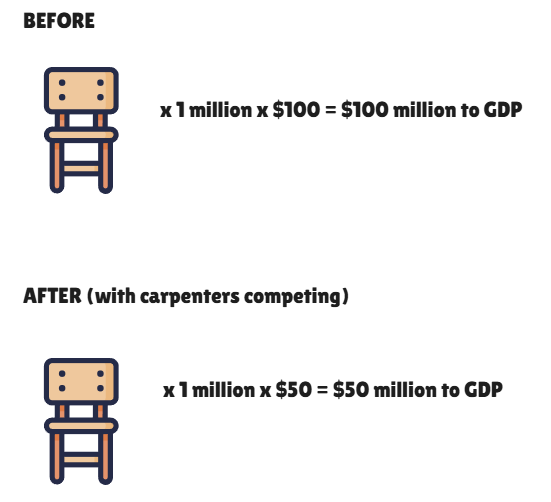
Why don’t productivity improvements reduce GDP?
This may sound pretty confusing. Politicians and economists typically assume that GDP going up is a good thing, and talk about how “productivity improvements” are the key to boosting economic growth. But my chair example is suggesting that increasing productivity should lower GDP and economic growth!! So what’s going on here?
I must now confess that my chair example relies on a bunch of rather unrealistic assumptions. However, this doesn’t mean my example is garbage. Taking some time to understand these assumptions will give us a better appreciation of what’s really going on when we look at economic statistics like GDP.
So let’s unpack them.
Imperfect competition
The first assumption in my chair example that may not hold up in reality is perfect competition among carpenters. Above, I assumed that all chairs were identical and that every carpenter would have equal access to this superior new chair-carving technique.
But in the real world, productivity improvements rarely spread freely. Suppose that the superior chair-carving technique were discovered by a giant chair-making company—let’s call them Big Chair—which serves 80% of the chair market. Big Chair will guard this superior technique as a trade secret. Employees who learn of the technique will have to sign NDAs and non-compete agreements so they don’t leak the technique to rival chairmakers.
In this case, Big Chair might decide not to lower prices at all. Since it can produce chairs at a lower cost than its competitors, the superior technique will increase Big Chair’s profits even if it doesn’t change its prices. People buying chairs are no better off, but Big Chair can fully enjoy the benefits of its productivity improvement.
Alternatively, Big Chair could lower prices slightly to capture an even larger share of the chair market. Let’s say it lowered prices to $95. In my earlier example, when everyone had access to the new chair-carving technique, a price war broke out. But this time, the other carpenters don’t have access to the new technique, so may not be able to lower their prices. Any carpenter that just broke even at $100 per chair would be forced out of the market.
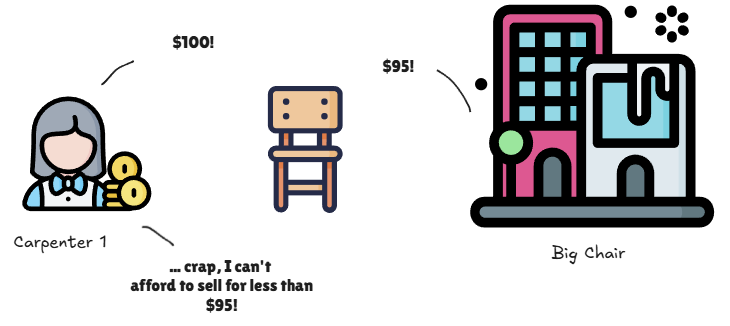
Consumers would be slightly better off, as they still save $5 on chairs. Just not as much as if all carpenters had this superior chair-carving technique.
So this illustrates how, without competitive pressure, producers can pocket the gains from productivity improvements. But imperfect competition only explains why productivity improvements might not reduce GDP. It doesn’t tell us why productivity improvements seem to instead increase GDP. To understand that, we need to look at how productivity affects demand.
Induced demand in the productive sector
Up to now, I’ve assumed that the demand for chairs remained constant even as prices fell from $100 to $50. But in real life, lower prices tend to increase demand—and therefore sales. This phenomenon is known as induced demand.
One of the most famous examples of induced demand is Jevons paradox, named after the English economist William Stanley Jevons in the midst of the Industrial Revolution. In his 1865 book The Coal Question, Jevons observed that when technology improved the efficiency of coal, energy prices fell, and demand surged.
It’s easy to underestimate the power of induced demand because, at a personal level, we might not feel very price-sensitive. Even if chair prices drop by 50%, you’re probably not going to race out and double the number of chairs in your home. Similarly, even if the price of energy halves, you’re not going to start doubling the length of your showers or cranking your thermostat up to 40°C.
But the power of induced demand is easier to appreciate when we zoom out. Imagine someone who had been tossing up whether to replace the 6 chairs in their old dining room set. They might have found the $600 cost to be too steep, but $300 may well have been enough to tip the scales. So the price drop causes them to buy 6 more chairs than they otherwise would’ve. The same applies to energy—as the price of energy drops, society as a whole will find more uses for it.
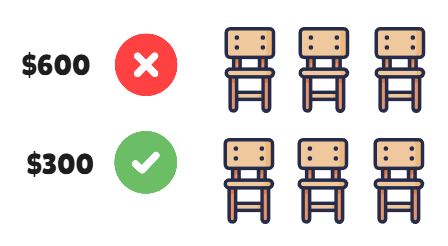
The power of induced demand is especially noticeable when we have international trade. Although my chair example has assumed a closed economy for simplicity, the global market can absorb a lot of chairs. If the superior chair-carving technique is not spread throughout the entire world, carpenters with access to the technique will be able to win market share off the carpenters without access.
Induced demand in other sectors
There are, however, limits to induced demand. While society can plausibly find plenty of uses for cheap energy, it may not be able to find as many uses for cheap chairs. At some point, society may reach some chair saturation point. Everyone, everywhere, has all the chairs their hearts desire.
By this point, further productivity improvements in chair manufacturing can no longer increase demand for chairs. Chair scarcity has already been eliminated! Still, if those productivity improvements continue to lower chair prices, consumers will have more money to spend on other goods and services. They can use their cost savings to buy more tables, or food, or clothing, or whatever.
You might think there’s a limit to how much demand for other goods and services can increase. After all, aren’t our desires limited? Unfortunately, as I’ve explained previously, a single zero-sum game like land or status can absorb unlimited amounts of money. So competition over zero-sum goods has the potential to negate productivity gains. This dynamic helps explain why our “wants” never seem to wane, not matter how productive we get.
Conclusion
My friend was right to question why productivity improvements don’t seem to reduce GDP. In theory (admittedly with some strong assumptions), it should. In practice, it does not.
Part of the reason is that imperfect competition lets producers capture the benefits of productivity improvements while GDP stays flat. The other part is that when competition drives down chair prices, it triggers induced demand in some form, which absorbs the cost savings and cause GDP to rise. That’s what we always seem to observe. That is why politicians talk about boosting productivity and economic growth as if they were the same thing.
As I explain in my next post, GDP per capita has been reasonably strongly correlated with human welfare up to now, even though it has never directly measured welfare. However, that correlation has already started to weaken. I believe the GDP and welfare are only going to decouple further as we move into the age of AI.
Let me know what you think of this post in the comments below!
Images in this post were created using icons by Lima Studio in CC Attribution License via SVG Repo.
If you enjoyed this blog post, you may also like:
- Can zero-sum games negate productivity gains?
- We all play different status games
- “Thinking in Systems” and Economics
- 1I’m mostly going to focus on GDP, but the same should also apply to GDP per capita if population stays constant. It is possible that productivity improvements may affect population sizes—such as by changing fertility rates—but I’m not going to get into that.
- 2You can also get a productivity improvement if you produce higher quality outputs with the same amount of inputs. Since quality is much harder to measure, I’ll be assuming constant quality throughout this post.
8 thoughts on “Shouldn’t productivity improvements reduce GDP?”
Called it! I instantly thought “Jevon’s Paradox” but all the same a very interesting and detailed exploration of the mechanisms at work. Very clear (and I like the illustrations—clean).
I was also thinking about the shoes on my feet, where I’ve paid $150 more than I need to because these have a little swoosh symbol on the side of them. What we’re willing to pay for something is also somehow socially conditioned and quite robustly resists massive reductions in price (with similar quality)—or perhaps I’m just a sucker. Where there’s a race to the bottom there’s also a massive incentive for manufacturers to avoid that race, and they have a lot to gain by artificially bolstering prices by whatever means is available.
Thank you!
Brands are a tricky one. They’re definitely a sign of imperfect competition but, since we don’t have perfect information in the real world, they can also serve a valuable signalling function. There’s an interesting study that shows that chain restaurants tend to cluster by locations with a lot of transient customers (e.g. highway exits) because customers don’t know what’s good around there, and the chain’s brand assures them of a certain level of quality. Similarly, the little swoosh symbol on your shoes likely gives you some assurance that they will last a bit longer than a pair that is $150 cheaper.
Of course, whether the information conveyed by the brand is valuable or merely social conditioning is a tricky line to draw 🙂
Ok, I ended up tying myself in knots when I tried to think through this.
At first I got stuck because I was thinking:
1. Carpenters double productivity and let’s assume perfect competition so the chair price goes from $100 to $50
2. They still work 40 hours, but now spend only 20 hours on chairs and 20 hours on something else
3. The something else initially pays the same hourly wage (why would it pay more?) and earns zero profit
Under those conditions the lost $ from chairs is exactly replaced by wages int he new activity, so nominal GDP is flat (real GDP is higher though). But I was confused because I expected nominal GDP to also rise.
I think I get it now. The buyers’ real income has increased because they have $50m extra a year. That translates to extra demand for cafes, barbers, holidays etc.
Importantly, the demand curve in those sectors shifts right.
The stronger demand implies a higher marginal revenue product. That is, a cafe can profitably hire extra labour at (say) $24 per hour whereas before it only made sense at $20 per hour. That higher wage is additional nominal value add.
Plus, if chair demand is less than perfectly inelastic, chair value-add itself might increase (you already made that point).
Maybe that’s exactly what you were saying
Yes, I think we’re saying the same thing, but you’re working through the labour supply side in the section about “Induced demand in other sectors”, whereas I ignored that and focused on the demand side.
Re: nominal vs real GDP. I’m not sure how helpful the distinction is here. With constant money and labour supply, if productivity and output both rise, we’d see the same amount of money chasing a greater number of goods, which has a deflationary effect. Except, as the Baumol effect points out, prices rise in sectors where productivity increases are slower – like your cafe. The supply of some things like land and positional goods will always be inelastic, so increased demand in those sectors will show up as a higher prices. That should have an offsetting inflationary effect.
But the inflationary effect may not fully offset the deflationary effect, and even if it did there would still be distributional impacts because the economy is really complex (e.g. increased demand for coffee might show up in higher wages, but increased demand for land may not). So I think nominal GDP can be quite misleading here, which is kind of the point I was trying to make. Productivity improvements are good – but GDP per capita going up is not necessarily good. Does that make sense?
Just on the real vs nominal: if we hold the money supply constant while productivity rises, then by the quantity theory of money, either prices fall (aggregate deflation), or velocity rises (people spend cash faster) keeping prices flat.
Quantity theory of money is MV = PY. M = money stock, v = velocity of money (how many times money changes hands per year in final transactions). P. = prices. Y = real output.
So real GDP really just measures quantities, rather than values. Ifsector-specific prices move in opposite directions (Baumol’s disease up, tech goods down), real GDP still isolates the quantity effect.
So if land prices increase, but number of chairs goes up, because we have the same amount of land but more chairs, real GDP increases. (technically land prices don’t actually go into GDP, but rents do).
But I agree that distribution might be important. And true that real GDP per capita going up isn’t always good, but that’s for the usual reasons already known about car crashes increasing GDP etc.
Thanks for that explanation. Yeah, I probably shouldn’t have said the distinction between nominal and real is not that helpful here – I agree that we should focus on real GDP, not nominal. I also agree that if we have the same amount of land but more chairs, then Y should go up.
But even with real GDP, I am still reluctant to conclude that Y going up is always good (and not just because of car crashes). The distribution piece is a big part of it. If land prices go up while chair prices fall, real GDP per capita goes up but carpenters could be worse-off. Even though, at an abstract level, we just have more output in the economy, there is effectively a transfer from carpenters (whose labour is worth less in terms of land they can buy) to existing landholders (whose land is worth more in terms of the chairs they can buy). And if there are many more carpenters than landowners, total welfare could decrease even as real GDP goes up, unless there is some mechanism like a land value tax to redistribute away from landowners.
My other main issue with real GDP is that it only measures quantities traded, when what we really care about is consumer and producer surpluses generated by trade. It’s also just really hard in practice to isolate the quantity effect — the chair example is pretty straightforward as you can count the chairs produced, but it’s much harder with goods that are sometimes provided for free (e.g. clean water, digital products, including potentially AI services). So even though in theory P and Y are separate, in practice Y doesn’t measure output unless it has a P attached – even though that (free) output may generate significant consumer surpluses. Anyway I’m planning to cover these points in my next post.
You might be interested in this essay on GDP and CPI: https://devinhelton.com/economics/gdp-and-cpi-are-broken
Some of the author’s articles are pretty good too, especially “Rent-seeking epidemic” and “The economic classes and their respective plights”: https://devinhelton.com/
Thanks for the recommendation! Interesting essay, and I agree with much of what Devin says about the limits of GDP, especially in the difficulty of adjusting for quality. I am slightly more optimistic than him about GDP figures – I don’t think they are as useless as he suggests. But I agree that it is important to understand how the numbers are actually compiled and the assumptions behind them if you’re relying on them for anything important. I also agree that trying to “boil the economy down to a single number” is foolish – I think it is better to refer to a range of different measures (GDP, GDP per capita, Labour productivity, GNI, GNI per capita, unemployment rate, labour force participation rate, etc) to try and work out what is going on in the economy.
Devin seems to make a few basic mistakes, though. For example, when talking about how GDP excludes imports, he gives the example of Saudi Arabia switching from buying US planes to European Airbus planes, and says that wouldn’t show up in GDP because GDP excludes imports. But the US airplanes are an export, and the fall in exports would show up in GDP. I also disagree with his argument that real GDP is a less useful measure than nominal GDP. His separate article about the US national debt also has some major problems.